

Fashion, Sewing Patterns, Inspiration, Community, and Learning. Mi primera máquina de coser: Guía de tiendas de telas por Madrid. ¡Buenos días!
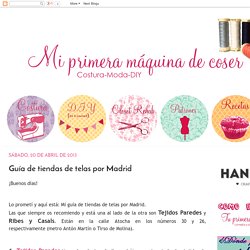
Lo prometí y aquí está: Mi guía de tiendas de telas por Madrid. Las que siempre os recomiendo y está una al lado de la otra son Tejidos Paredes y Ribes y Casals. Están en la calle Atocha en los números 30 y 26, respectivamente (metro Antón Martín o Tirso de Molina). 1. Tejidos Paredes tiene dos plantas. 2. 4. Contemporary Smocking Techniques. Tightly pulled vertical smocking.
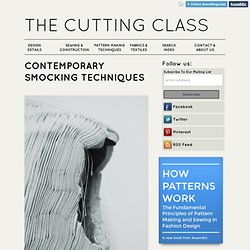
Image via Trans.lu.cent» Smocking is a fabric manipulation technique that is generally created by using hand stitching to create areas of tension and release in the fabric. This results in very sculptural effects that can sometimes appear far more complex then they actually are. There are some smocking / pleating machines that will speed up the process, but many eye catching effects are created by marking out the fabric using dots or a grid. Manoeuvring between the dots or corners of the grid with thread and holding stitches can then create different effects depending on the path that you take. 30 Top Sewing Secrets - Mary Roehr Books & Video. A Romantic Bedroom Retreat with Rowan & FreeSpirit Fabrics: Specialty Feet And Tools For Working With Trims. Creating a lush and luxurious Romantic Bedroom Retreat is the perfect opportunity to incorporate a few of the wide variety of trims available.
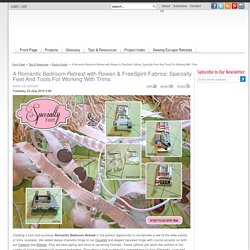
We added dense chainette fringe to our Coverlet and elegant tasseled fringe with crystal accents on both our Valance and Bolster. Plus we have piping and more in upcoming tutorials. These options just prick the surface of the variety of trims available both in-store and online. They always look so beautiful wrapped around their little bolts, rows and rows from which to choose. But many people shy away from using these gorgeous embellishments because they're unsure how to sew them in place. If you’re wondering why you should purchase the same brand of foot as your sewing machine, it’s because each machine manufacturer has designed its machine feet to work most effectively with their feed system, shank height (high or low), and the maximum stitch width (or the width of the needle plate opening) to achieve optimal stitching results. House of Pinheiro: Sewing 101: Know your presser foot. {A}Button hole foot: Application: As the name describes, this presser foot is used for making button holes.

Each machine offers different styles of button holes stitches from bound to keyhole etc. You can use this foot for darning and bar tacks. The button hole sensor size varies. Mine has a maximum button size of 3 cm (1 inc). {B}Cut & sew foot: Application: This presser foot is a little bit more expensive them most in the market but for those who like a neat finish and don't have an overlocker, this presser foot can be a great solution. {C}Walking foot: Application: This presser foot is used to maintain both layers of fabric matching, specially helpful when sewing thick, multiple layers or difficult materials that tends to stick or glide. {D}Open toe quilting foot: Application: This is used mainly for free-motion quilting and machine embroidery as the large opening provide wide visibility and freedom of movement.
{F}Hemming stitching foot. Hems. 1930s Sewing Secrets Vintage Magazine. Fundamentals of Pattern Making: Pattern Notches - The Cutting Class. Alexander Wang, RST13, New York.

When a piece of fabric is first cut out, it has none of the markings that are seen on the pattern. For a machinist to sew these two pieces of fabric together effectively they need to know: How much value has been allowed as seam allowance? How do the two seams match to each other? The way that a pattern maker indicates this information to the machinist is through the use of pattern notches. Pattern notches are small marks made on the pattern to ensure that one pattern piece will match up to the pattern next to it. On a cardboard pattern, they will look like small indents around the outside edge of the seam allowance.
The notches that are made on the cardboard pattern are transferred onto the cut fabric by the cutter. A Guide to Understand a Sewing Machine and the Features Available. A Buyer's Guide to Your First Sewing Machine. Investing in a sewing machine can be an exciting yet daunting task.
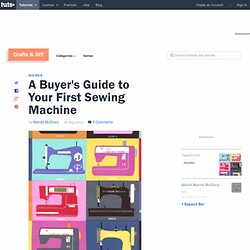
It's hard to know where to start with seemingly endless makes and models on the market. Finding the right sewing machine really depends on how you intend to use it, but before you give yourself a headache with all the possibilities out there, it's worth asking some basic questions. My Sewing Machine fabric by Dorothy Prudie Fabrics. 10 Things to Consider Before Buying a Sewing Machine 1.
Everyone has a budget and recognising whether or not you can actually afford the machine that you want is the first step to choosing the one that's right for you. Grading Rulers and French Curves - The Cutting Class. Grading ruler and set of french curves.
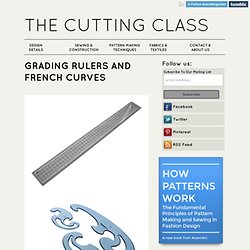
No self respecting pattern maker likes to be without an accurate ruler. The best rulers for pattern making are made of strong clear plastic and have a grid across the whole ruler making it easy to accurately mark seam allowance. Clear grid rulers, such as the one pictured, are great for marking seam allowance on straight edges where you can get a completely parallel line. They are also ideal tools for grading patterns, hence they are often referred to as grading rulers. Even around curves you can line up the grid of the ruler correct to the mm and make a small line marking, pivoting your ruler along the curve to create a dashed line.
The images above show examples of grading rulers and french curves, though of course they come in many varieties and you are best to test out which type works best for you.